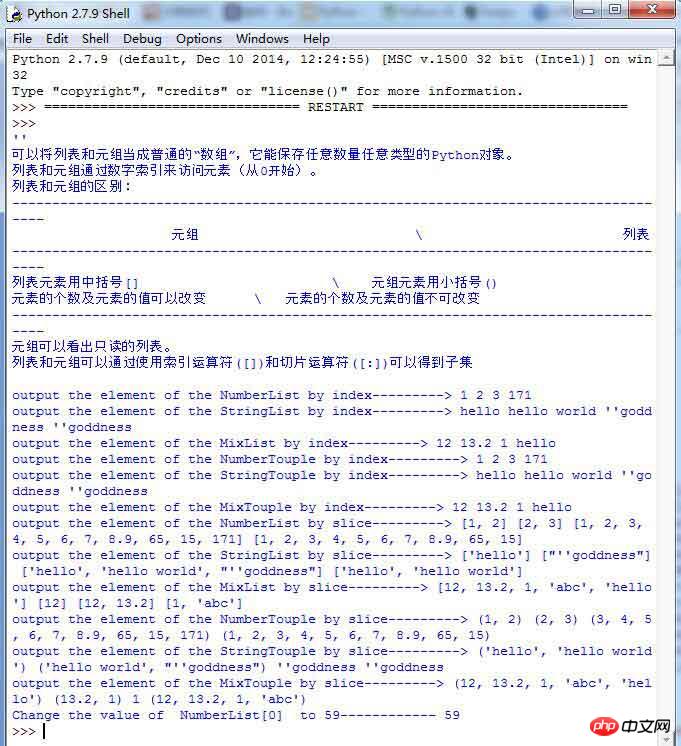Maison >développement back-end >Tutoriel Python >Explication détaillée des définitions d'utilisation des listes et des tuples en Python
Explication détaillée des définitions d'utilisation des listes et des tuples en Python
- 黄舟original
- 2017-07-26 15:43:071537parcourir
Cet article présente principalement la définition et l'utilisation des listes et des tuples Python. Il analyse les fonctions, les différences, les définitions et l'utilisation des listes et des tuples en Python avec des exemples. Les amis dans le besoin peuvent s'y référer
Le. les exemples de cet article décrivent la définition et l'utilisation des listes et des tuples Python. Partagez-le avec tout le monde pour votre référence, les détails sont les suivants :
#coding=utf8
print '''''
可以将列表和元组当成普通的“数组”,它能保存任意数量任意类型的Python对象。
列表和元组通过数字索引来访问元素(从0开始)。
列表和元组的区别:
------------------------------------------------------------------------------------
元组 \ 列表
------------------------------------------------------------------------------------
列表元素用中括号[] \ 元组元素用小括号()
元素的个数及元素的值可以改变 \ 元素的个数及元素的值不可改变
------------------------------------------------------------------------------------
元组可以看出只读的列表。
列表和元组可以通过使用索引运算符([])和切片运算符([:])可以得到子集
'''
NumberList=[1,2,3,4,5,6,7,8.9,0101,017,0xab]
StringList=['hello',"hello world",'''''goddness''']
MixList=[12,13.2,01,'abc','hello']
NumberTouple=(1,2,3,4,5,6,7,8.9,0101,017,0xab)
StringTouple=('hello',"hello world",'''''goddness''')
MixTouple=(12,13.2,01,'abc','hello')
print "output the element of the NumberList by index--------->",NumberList[0],NumberList[1],NumberList[2],NumberList[-1]
print "output the element of the StringList by index--------->",StringList[0],StringList[1],StringList[2],StringList[-1]
print "output the element of the MixList by index--------->",MixList[0],MixList[1],MixList[2],MixList[-1]
print "output the element of the NumberTouple by index--------->",NumberTouple[0],NumberTouple[1],NumberTouple[2],NumberTouple[-1]
print "output the element of the StringTouple by index--------->",StringTouple[0],StringTouple[1],StringTouple[2],StringTouple[-1]
print "output the element of the MixTouple by index--------->",MixTouple[0],MixTouple[1],MixTouple[2],MixTouple[-1]
print "output the element of the NumberList by slice--------->",NumberList[0:2],NumberList[1:3],NumberList[0:],NumberList[:-1]
print "output the element of the StringList by slice--------->",StringList[0:1],StringList[2:3],StringList[0:],StringList[:-1]
print "output the element of the MixList by slice--------->",MixList[0:],MixList[:1],MixList[0:2],MixList[2:-1]
print "output the element of the NumberTouple by slice--------->",NumberTouple[0:2],NumberTouple[1:3],NumberTouple[2:],NumberTouple[:-1]
print "output the element of the StringTouple by slice--------->",StringTouple[0:2],StringTouple[1:3],StringTouple[2],StringTouple[-1]
print "output the element of the MixTouple by slice--------->",MixTouple[0:],MixTouple[1:3],MixTouple[2],MixTouple[:-1]
NumberList[0]=59
#NumberTouple[0]=56
print "Change the value of NumberList[0] to 59------------",NumberList[0]
#print "Can not change the value of NumberTouple[0] to 56------------",NumberTouple[0]Résultats en cours :

Ce qui précède est le contenu détaillé de. pour plus d'informations, suivez d'autres articles connexes sur le site Web de PHP en chinois!

